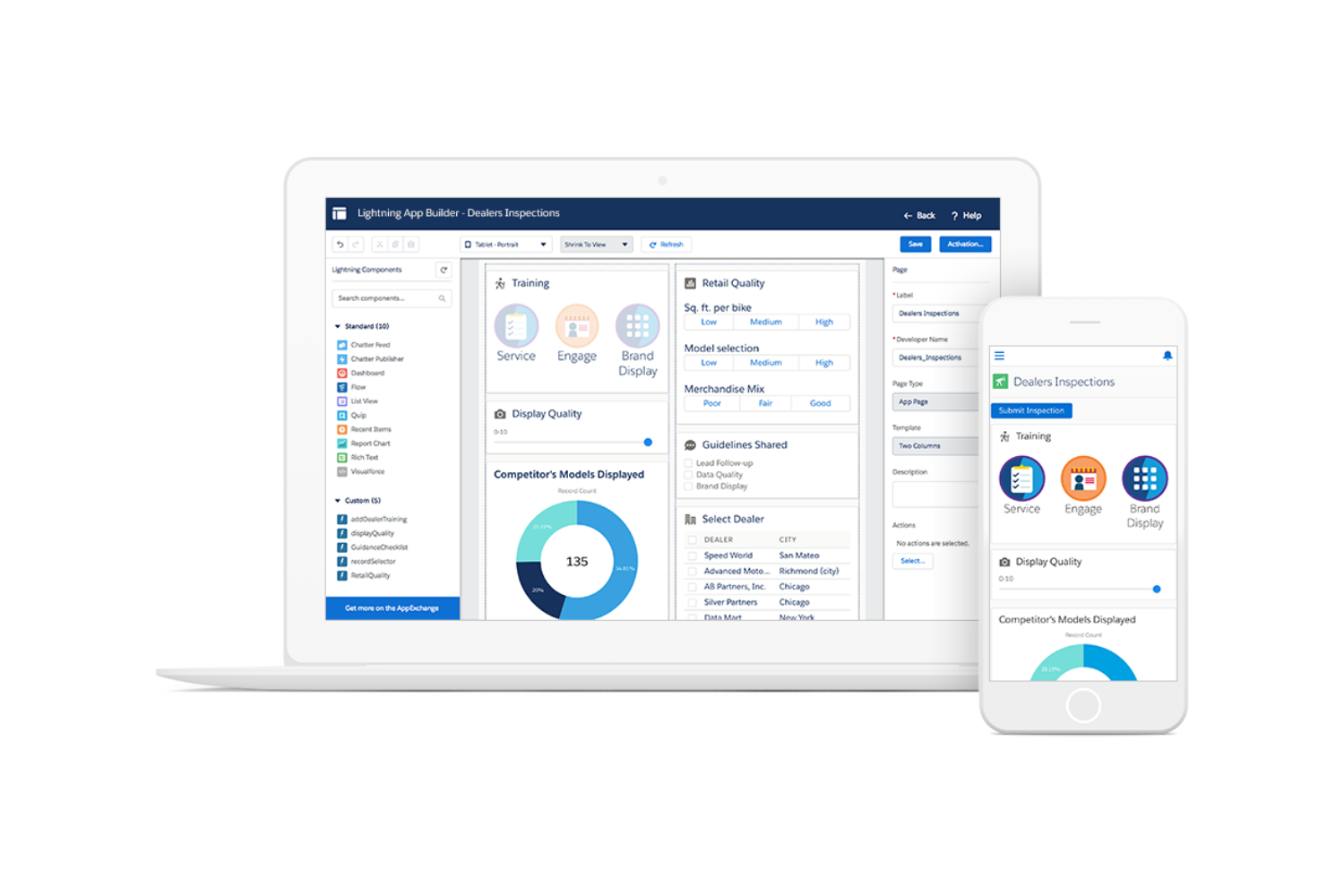Introduction
Welcome to the world of Software as a Service (SaaS) products! Whether you’re a startup founder or part of a well-established company, marketing your SaaS product is crucial for its success. With the increasing competition in the market, it’s important to differentiate your product and reach your target audience effectively.
The goal of marketing your SaaS product is to create awareness, generate leads, and convert those leads into loyal customers. Effective marketing strategies can help you establish a strong brand presence, increase your customer base, and ultimately drive revenue growth.
In this article, we will explore various strategies and techniques to market your SaaS product successfully. From understanding your target market to fostering customer loyalty, we will cover every step of the marketing process.
Before diving into the specific strategies, it’s important to remember that marketing is not a one-size-fits-all approach. The key to successful marketing lies in understanding your target market and tailoring your efforts accordingly.
By identifying your target audience, you can create a marketing strategy that resonates with their needs, pain points, and preferences. This will enable you to craft compelling messages and effectively communicate the value of your SaaS product.
Furthermore, a strong value proposition is essential for capturing the attention of potential customers. Your value proposition should clearly highlight the unique features and benefits of your SaaS product and differentiate it from the competition.
Once you have a solid understanding of your target market and a compelling value proposition, you can start developing a comprehensive marketing plan. This plan will outline the specific marketing activities and channels you will utilize to reach your target audience.
Your marketing plan should include a mix of online and offline strategies, as well as a clear timeline and measurable goals. This will help you stay organized and focused on achieving your marketing objectives.
In the following sections, we will delve deeper into various marketing strategies for your SaaS product. From building a persuasive website to leveraging content marketing, social media marketing, and email campaigns, we will explore the most effective ways to promote your product.
Additionally, we will discuss the importance of optimizing your SaaS product for search engines and utilizing influencer marketing to amplify your reach. Measuring and analyzing your marketing efforts is also crucial for identifying areas of improvement and making data-driven decisions.
Finally, we will explore strategies for fostering customer loyalty and retention. Building strong relationships with your existing customers is just as important as acquiring new ones. By providing exceptional customer support and continuously adding value to your product, you can cultivate a loyal customer base that becomes your brand advocate.
So, without further ado, let’s delve into the world of marketing a SaaS product and discover strategies that will propel your product toward success.
Understanding your target market
Before you can effectively market your SaaS product, it is crucial to have a deep understanding of your target market. This involves identifying your ideal customer profile and gaining insights into their needs, pain points, and preferences.
Start by conducting thorough market research to identify the characteristics and demographics of your target audience. This includes factors such as age, profession, industry, location, and company size. By understanding these aspects, you can tailor your marketing efforts to resonate with their specific needs and preferences.
Another key component of understanding your target market is identifying their pain points and challenges. What problems are they facing that your SaaS product can solve? By knowing their pain points, you can position your product as the solution and effectively communicate how it can address their specific needs.
It is also vital to understand the buying behaviors and decision-making processes of your target market. Are they early adopters who are willing to try new products, or are they more risk-averse and hesitant to change? By understanding their buying behaviors, you can tailor your marketing messages and strategies accordingly.
One effective way to gather insights about your target market is by conducting surveys and interviews with existing customers or potential leads. Ask them about their preferences, pain points, and what they look for in a SaaS product. This firsthand information can be invaluable in shaping your marketing strategies.
Furthermore, analyzing competitors and their target markets can provide valuable insights. Identify who your main competitors are and analyze their marketing strategies and positioning. This can help you uncover untapped opportunities in the market and differentiate your SaaS product from the competition.
Utilize analytics tools to gather data about your website visitors, their demographics, and their behavior on your site. This data can provide valuable insights into the effectiveness of your marketing efforts and help you make data-driven decisions.
By thoroughly understanding your target market, you can create marketing messages that resonate with them, choose the most effective marketing channels, and position your SaaS product as the solution to their problems. This knowledge will guide your marketing efforts and increase your chances of success in reaching and engaging your target audience.
Creating a value proposition
A value proposition is a clear and compelling statement that communicates the unique benefits and value your SaaS product offers to your target market. It is a crucial element of your marketing strategy as it helps differentiate your product from competitors and captures the attention of potential customers.
To create a strong value proposition, you need to understand the needs and pain points of your target market. What problems are they facing? How does your SaaS product address those problems? What specific benefits does your product offer?
Start by identifying the key features and functionalities of your SaaS product. Highlight how these features solve your target audience’s pain points and make their lives easier or more efficient. This will form the foundation of your value proposition.
Next, focus on the benefits that your product delivers. Think about the positive impact it can have on your customers’ businesses or personal lives. Does it save them time, money, or resources? Does it increase their productivity or provide valuable insights?
When crafting your value proposition, make it concise and easy to understand. Use simple language that clearly communicates the benefits of your product. Avoid jargon or technical terms that may confuse your audience.
Avoid focusing solely on the features of your product. Instead, highlight the outcomes and benefits that your customers can achieve by using your product. This will resonate more with your audience and convince them of the value your product provides.
Consider incorporating evidence or social proof into your value proposition. This could be in the form of testimonials, case studies, or statistics that demonstrate the positive impact your product has had on previous customers. By showcasing real-life examples, you build trust and credibility with your audience.
Another effective strategy is to create different value propositions for different segments of your target market. Not all customers have the same needs and priorities, so tailoring your value proposition to specific segments can make it more relevant and persuasive.
Regularly evaluate and refine your value proposition as your product evolves and market dynamics change. Continuously gather feedback from customers and prospects to understand what resonates most with them. Use this feedback to iterate and improve your value proposition over time.
A well-crafted value proposition can be a powerful tool in attracting and converting potential customers. It helps you differentiate your SaaS product, communicate its unique benefits, and convince your target audience that your product is the best solution for their needs.
Developing a marketing plan
A well-developed marketing plan is essential for effectively promoting your SaaS product. It provides a roadmap for your marketing activities and ensures that you are targeting the right audience with the right messages at the right time. Here are some key steps to consider when developing your marketing plan:
1. Set clear goals: Start by defining your marketing objectives. What do you want to achieve through your marketing efforts? Whether it’s increasing brand awareness, generating leads, or driving conversion, having clear goals will guide your marketing decisions and help you measure success.
2. Identify your target audience: As mentioned in the previous section, understanding your target market is crucial. Identify the key demographics, characteristics, and pain points of your target audience. This will enable you to tailor your marketing messages and campaigns to resonate with them.
3. Choose your marketing channels: Consider the most effective marketing channels to reach your target audience. This could include a combination of online and offline channels, such as social media, content marketing, email marketing, search engine optimization (SEO), paid advertising, events, and partnerships. Select the channels that align with your target audience’s preferences and behaviors.
4. Craft compelling messages: Develop a strong and consistent messaging framework that highlights the unique value your SaaS product offers. Tailor your messages to address your target audience’s pain points and position your product as the solution. Use clear and concise language that resonates with your audience.
5. Create a content strategy: Content marketing plays a vital role in promoting your SaaS product. Develop a content strategy that includes valuable and informative content such as blog posts, videos, ebooks, and whitepapers. This content should provide value to your target audience while subtly promoting your product. Use SEO techniques to optimize your content for search engines and increase organic visibility.
6. Allocate a budget: Determine the budget for your marketing activities. Consider both the cost of implementing various tactics and the desired return on investment. Allocate your budget strategically across different channels based on their effectiveness in reaching and engaging your target audience.
7. Set a timeline: Create a timeline that outlines the specific marketing activities and their deadlines. This will help you stay organized and ensure that your marketing efforts are coordinated and executed timely and effectively.
8. Measure and analyze: Implement tracking mechanisms to measure the success of your marketing campaigns. Monitor key metrics such as website traffic, conversion rates, engagement, and customer acquisition costs. Analyze the data to identify areas of improvement and make data-driven decisions to optimize your marketing efforts.
Remember that your marketing plan should be flexible and adaptable. Continuously evaluate and refine your strategies based on market conditions, customer feedback, and performance metrics. Regularly reassess your goals and adjust your plan accordingly to ensure ongoing success in promoting your SaaS product.
Building a compelling website
Your website serves as the online face of your SaaS product and is often the first point of contact for potential customers. Therefore, it is essential to create a compelling and user-friendly website that effectively showcases your product and captures the attention of visitors. Here are some key elements to consider when building your website:
1. Clear and visually appealing design: Create a clean and professional design that reflects your brand image. Use a layout that is easy to navigate and ensures a seamless user experience. Incorporate visually appealing elements, such as high-quality images and graphics, to captivate visitors and make a lasting impression.
2. Engaging and persuasive content: Craft compelling and persuasive content that clearly communicates the value and benefits of your SaaS product. Use concise and compelling language to capture the attention of visitors and encourage them to explore further. Highlight key features, functionalities, and unique selling points that differentiate your product.
3. Intuitive navigation: Ensure that your website has a clear and intuitive navigation structure. Make it easy for visitors to find the information they are looking for and navigate between pages. Include a user-friendly menu, search functionality, and breadcrumbs to enhance the overall user experience.
4. Responsive design: Optimize your website for mobile devices by implementing a responsive design. With the increasing use of smartphones and tablets, it is essential to provide a seamless browsing experience across different screen sizes. A responsive design ensures that your website adapts and displays properly on all devices.
5. Call-to-action (CTA) buttons: Strategically place compelling CTA buttons throughout your website to guide visitors towards desired actions, such as signing up for a free trial, requesting a demo, or subscribing to your newsletter. Use clear and action-oriented language to encourage visitors to take the next step.
6. Trust signals: Incorporate trust-building elements on your website to establish credibility and instill trust in your visitors. This can include customer testimonials, case studies, certifications, security badges, and social proof. Displaying these trust signals can help alleviate any doubts or hesitations potential customers may have.
7. Optimize for search engines: Implement SEO best practices to ensure your website appears in relevant search engine results. Conduct keyword research to identify the terms and phrases your target audience is using to search for solutions like yours. Incorporate these keywords naturally throughout your website’s content, meta tags, and URLs to improve your organic visibility.
8. Analytics and tracking: Set up analytics tools to track website metrics, such as traffic, conversion rates, and user behavior. Analyzing these metrics will provide insights into the effectiveness of your website and help you make data-driven decisions to optimize performance.
9. Regular updates and maintenance: Keep your website up to date by regularly adding fresh content, updating product information, and fixing any technical issues. Regularly monitor your website’s performance and usability to ensure a smooth experience for visitors.
A compelling website is crucial in creating a positive first impression, establishing credibility, and driving conversion for your SaaS product. Invest time and effort in building a website that reflects the value of your product and provides an exceptional user experience.
Leveraging content marketing strategies
Content marketing is a powerful strategy for promoting your SaaS product and establishing thought leadership in your industry. By creating valuable and informative content, you can attract, engage, and convert your target audience. Here are some effective content marketing strategies to leverage:
1. Develop a content strategy: Start by developing a comprehensive content strategy that aligns with your marketing goals and target audience. Identify the topics and themes that are relevant to your industry and target market. Define the types of content you will create, such as blog posts, videos, ebooks, webinars, or infographics.
2. Create valuable and relevant content: Focus on creating content that provides value to your target audience. Address their pain points, answer their questions, and provide actionable insights. This will establish your credibility and position your SaaS product as the solution to their needs.
3. Utilize different content formats: Experiment with different formats to cater to different learning preferences. Some people prefer reading blog posts, while others prefer watching videos or listening to podcasts. By diversifying your content formats, you can reach a wider audience and keep them engaged.
4. Optimize content for search engines: Incorporate SEO best practices into your content creation process to improve your organic visibility. Conduct keyword research to identify the terms and phrases your target audience is searching for. Use these keywords naturally within your content to increase its search engine rankings.
5. Promote your content: Simply creating great content is not enough; you also need to promote it to reach your target audience. Share your content on social media platforms, engage in relevant online communities, and collaborate with influencers to increase its visibility. Encourage your audience to share, comment, and engage with your content.
6. Guest blogging and thought leadership: Contribute guest posts to industry blogs and publications to expand your reach and establish yourself as a thought leader. This not only increases your visibility but also builds trust and credibility with your target audience.
7. Offer valuable resources and tools: Create valuable resources such as templates, checklists, or calculators that address specific pain points or help your audience in their decision-making process. This positions you as a trusted source of expertise and encourages visitors to engage with your brand.
8. Implement email marketing: Utilize email marketing campaigns to deliver your content directly to your target audience’s inbox. Segment your email list based on subscribers’ interests and preferences to provide personalized content recommendations. Use catchy subject lines and compelling copy to encourage opens and engagement.
9. Measure and analyze: Monitor the performance of your content marketing efforts regularly. Track metrics such as website traffic, engagement, conversion rates, and the number of leads generated. Analyze this data to identify trends, understand the preferences and interests of your audience, and make data-driven decisions for future content creation and promotion.
Content marketing allows you to provide value to your audience while building brand awareness and driving customer engagement. By implementing these strategies, you can leverage the power of content marketing to establish your SaaS product as a trusted authority in your industry.
Utilizing social media marketing
Social media has become an integral part of our lives, making it a powerful tool for marketing your SaaS product. By effectively utilizing social media platforms, you can increase brand awareness, engage with your target audience, and drive traffic to your website. Here are some key strategies for leveraging social media marketing:
1. Choose the right platforms: Identify the social media platforms that are most relevant to your target audience. Focus your efforts on platforms where your audience is most active and engaged. This could include popular platforms like Facebook, Twitter, LinkedIn, Instagram, or industry-specific platforms.
2. Develop a social media strategy: Create a comprehensive social media strategy that aligns with your marketing goals. Define your target audience, content themes, posting frequency, and engagement strategies. This helps you maintain a consistent presence and effectively communicate your brand message.
3. Establish your brand identity: Create a strong brand presence on social media by maintaining consistent branding elements such as your logo, color scheme, and tone of voice. Reflect your brand personality in your social media content to engage and resonate with your audience.
4. Engage with your audience: Social media is a two-way communication channel. Respond to comments, messages, and mentions from your audience. Encourage conversations and foster a sense of community by asking questions, conducting polls, and responding to feedback.
5. Share valuable content: Provide value to your social media followers by sharing informative and relevant content. This can include blog posts, videos, infographics, case studies, or industry news. Mix up your content formats to keep your audience engaged and ensure it aligns with their interests and pain points.
6. Utilize visual content: Incorporate eye-catching visuals such as images, graphics, and videos into your social media posts. Visual content often performs better and grabs the attention of users in their social media feeds.
7. Leverage user-generated content: Encourage your audience to create and share content related to your SaaS product. User-generated content acts as social proof and helps build trust and credibility. Share and showcase user-generated content to foster engagement and brand advocacy.
8. Use paid advertising: Consider utilizing paid advertising on social media platforms to amplify your reach and target specific audience segments. Experiment with different ad formats, such as sponsored posts, carousel ads, or video ads, to increase brand awareness and drive conversions.
9. Track and measure: Implement social media analytics tools to track key metrics such as followers, engagement, clicks, and conversions. Analyze this data to understand which platforms and content types perform best and make data-driven decisions to optimize your social media strategy.
Remember to stay up-to-date with the latest social media trends and adapt your strategies accordingly. Social media marketing is an ever-evolving field, so it’s important to continually refine your approach and experiment with new tactics to stay ahead of the curve.
Implementing email marketing campaigns
Email marketing remains one of the most effective and direct ways to engage with your target audience and nurture leads. By implementing email marketing campaigns, you can build relationships, drive conversions, and promote your SaaS product effectively. Here are some key strategies for implementing successful email marketing campaigns:
1. Segment your email list: Start by segmenting your email list based on factors such as demographics, interests, and engagement levels. This allows you to send more personalized and targeted emails that are relevant to each segment of your audience. Personalization helps increase open rates and engagement with your emails.
2. Create compelling subject lines: Craft attention-grabbing subject lines that entice recipients to open your emails. Use action-oriented language, personalization, or curiosity-evoking phrases to pique their interest. Experiment with different subject lines to see what resonates best with your audience.
3. Provide valuable content: Deliver valuable and relevant content to your email subscribers. This could include educational information, blog posts, industry insights, product updates, or exclusive offers. The content should provide value to your readers and help them solve their pain points or achieve their goals.
4. Design visually appealing emails: Design clean and visually attractive email templates that align with your brand. Use images, graphics, and colors that reflect your brand identity. Keep the layout simple and easy to read, with a clear call-to-action (CTA) that guides recipients toward the desired action.
5. Test different email types and formats: Experiment with different types of emails, such as newsletters, promotional emails, or transactional emails, to find what works best for your audience. Test different email formats, such as plain text vs. HTML, to see which yields better results in terms of open rates and click-through rates.
6. Automate your email campaigns: Set up automated email campaigns based on specific triggers or actions taken by subscribers. Examples include welcome emails, onboarding sequences, abandoned cart emails, or re-engagement campaigns. Automation allows you to nurture leads and guide them through the customer journey more effectively.
7. Optimize for mobile devices: With the majority of people accessing their emails on smartphones and tablets, it’s essential to ensure your emails are mobile-friendly. Use responsive design that adapts to different screen sizes and devices. Test your emails on various devices and email clients to ensure optimal display and usability.
8. Track and analyze: Utilize email marketing analytics to track key metrics such as open rates, click-through rates, and conversion rates. Analyze this data to understand the performance of your email campaigns, identify areas for improvement, and make data-driven decisions for future campaigns.
9. Comply with email marketing regulations: Ensure that your email marketing campaigns comply with relevant regulations, such as the CAN-SPAM Act or GDPR. Include clear opt-in and unsubscribe options, honor unsubscribe requests promptly, and follow best practices to maintain the trust and privacy of your subscribers.
Email marketing campaigns provide a direct line of communication with your audience. By implementing these strategies, you can leverage the power of email to effectively engage with subscribers, nurture leads, and promote your SaaS product.
Optimizing your product for search engines
Search engine optimization (SEO) plays a critical role in increasing the visibility of your SaaS product in search engine results and attracting organic traffic. By optimizing your product for search engines, you can improve its discoverability and reach a wider audience. Here are some key strategies for optimizing your product for search engines:
1. Keyword research: Conduct thorough keyword research to identify the terms and phrases that your target audience is using to search for solutions like yours. Use keyword research tools to find relevant keywords with a balance of search volume and competitiveness. Incorporate these keywords naturally into your product descriptions, website content, and meta tags.
2. On-page optimization: Optimize your product pages by including relevant keywords in the title tags, headers, meta descriptions, and URLs. Craft unique and compelling meta descriptions that summarize the value of your product and entice users to click through from search engine results. Use header tags (H1, H2, H3) to structure your content and make it more scannable for both users and search engine crawlers.
3. Quality content: Create valuable and informative content around your product that answers common questions, provides tutorials, or offers insights. High-quality content not only attracts organic traffic but also encourages other websites to link back to your product, indicating its authority and relevance to search engines.
4. Technical optimization: Ensure that your website is technically optimized for search engines. Improve your website’s loading speed by optimizing images, minimizing code, and leveraging caching techniques. Use clean and descriptive URLs that include relevant keywords. Implement proper header tags, alt tags for images, and schema markup to provide additional context to search engines.
5. Mobile optimization: With the increasing use of mobile devices for searching, it is crucial to have a mobile-friendly website. Optimize your website’s design and functionality for mobile users, ensuring that the site is responsive and easy to navigate on smaller screens. Google’s mobile-first indexing means that a mobile-friendly website is now essential for search engine optimization.
6. User experience: Prioritize a positive user experience on your website. Ensure that your navigation is intuitive and that users can easily find the information they need. Make sure your content is well-organized, visually appealing, and easy to read. Provide clear calls-to-action (CTAs) that encourage users to take desired actions, such as requesting a demo or signing up for a free trial.
7. Local SEO: If your SaaS product has a local presence, optimize it for local search results. Include location-specific keywords in your content and meta tags. Claim and optimize your Google My Business listing, ensuring that your business information is accurate and up to date.
8. Monitor and analyze: Regularly track your website performance and search engine rankings using SEO analytics tools. Monitor key metrics such as organic traffic, keyword rankings, and bounce rates. Analyze this data to identify opportunities for improvement and refine your SEO strategy.
Remember that SEO is an ongoing process, and it may take time to see significant results. Stay updated with the latest SEO trends and algorithm changes to adapt your strategies accordingly. By optimizing your SaaS product for search engines, you can increase its visibility and drive organic traffic, leading to more conversions and business growth.
Leveraging influencer marketing
In today’s digital landscape, influencer marketing has become a powerful strategy for promoting products and reaching a wider audience. By collaborating with influential individuals in your industry, you can leverage their trust and credibility to increase brand awareness and drive engagement. Here are some key strategies for leveraging influencer marketing:
1. Identify relevant influencers: Start by identifying influencers who align with your brand and target audience. Look for influencers who have a substantial following and a high engagement rate. Consider factors such as their expertise, content style, and values to ensure a strong alignment with your SaaS product.
2. Build relationships: Once you have identified potential influencers, focus on building genuine relationships with them. Engage with their content through comments, shares, and likes. This helps establish connections and familiarity before approaching them for a collaboration.
3. Collaborate on content creation: Work with influencers to co-create content that promotes your SaaS product. This could include sponsored blog posts, videos, social media posts, or live streams. Collaborating on content allows you to leverage their creativity and authenticity while ensuring that your product is showcased in a genuine and organic way.
4. Offer exclusive promotions: Provide influencers with exclusive promotions or discounts for their audience. This incentivizes their followers to try your SaaS product and provides a clear call-to-action. It also helps track the impact and effectiveness of the influencer collaboration through specific referral codes or links.
5. Micro-influencers: Consider working with micro-influencers, who have a smaller but highly engaged following. They often have a niche audience and can provide a more targeted reach. Micro-influencers tend to have higher engagement rates and can offer more authentic and cost-effective collaborations.
6. Affiliate partnerships: Explore the potential for affiliate partnerships with influencers. This involves providing them with a unique referral code or link and offering them a percentage of each sale generated through their promotion. This strategy aligns their interests with yours, as they are motivated to drive conversions and earn commissions.
7. User-generated content: Encourage influencers and their followers to create user-generated content related to your SaaS product. This can include reviews, testimonials, or case studies. User-generated content acts as social proof and can significantly boost brand credibility and trust.
8. Monitor and measure: Implement tracking mechanisms to monitor the effectiveness of your influencer marketing campaigns. Track metrics such as engagement rates, website traffic, conversions, and brand mentions. Analyze this data to evaluate the success of your collaborations and identify areas for improvement.
Transparency is vital in influencer marketing. Ensure that sponsored content is clearly disclosed to maintain transparency and comply with advertising regulations. Also, focus on building long-term relationships with influencers who truly believe in your product and can provide ongoing support and advocacy.
Leveraging influencer marketing can significantly expand your brand reach, establish credibility, and drive engagement. By partnering with influential individuals, you can tap into their loyal audience and benefit from the trust they have built, ultimately boosting awareness and growth for your SaaS product.
Measuring and analyzing marketing efforts
Measuring and analyzing your marketing efforts is crucial for understanding the effectiveness of your strategies and making data-driven decisions. By monitoring key metrics and analyzing the data, you can identify what’s working well, what needs improvement, and where to allocate your resources. Here are some key aspects to consider when measuring and analyzing your marketing efforts:
1. Set clear goals: Start by defining clear goals for your marketing initiatives. What do you want to achieve? Your goals could include increasing website traffic, improving conversion rates, growing your customer base, or boosting brand awareness. Clear goals provide a benchmark for measuring success.
2. Identify relevant metrics: Determine the key metrics that align with your goals. These may include website traffic, bounce rates, click-through rates, conversion rates, customer acquisition costs, return on investment (ROI), or social media engagement. Focus on the metrics that directly reflect the effectiveness of your marketing efforts.
3. Track and analyze data: Utilize analytics tools to track the identified metrics. Google Analytics is a powerful tool for tracking website data, while social media platforms often provide their own analytics tools. Regularly review the data to gain insights into trends, patterns, and areas of improvement. Look for correlations and causations to understand the impact of your marketing activities.
4. A/B testing: Conduct A/B testing to compare different variations of your marketing strategies. This could involve testing different ad headlines, email subject lines, landing page designs, or call-to-action buttons. A/B testing allows you to identify which variations perform better, enabling you to optimize your marketing efforts for maximum impact.
5. Analyze customer behavior: Dive deeper into customer behavior by analyzing user flows, session durations, and conversion paths on your website. Understanding how visitors navigate through your site and where they drop off can provide insights into potential areas of improvement or bottlenecks in the customer journey.
6. Customer feedback and surveys: Collect feedback from your customers through surveys, interviews, or customer satisfaction ratings. They can provide valuable insights into their experience with your brand and identify strengths and areas for improvement in your marketing strategies.
7. Competitive analysis: Monitor and analyze the marketing efforts of your competitors. Identify their strengths, weaknesses, and strategies. Understanding how your competitors are positioning themselves in the market can help you refine your own marketing approach and find opportunities to differentiate your SaaS product.
8. Regular reporting: Create regular reports that summarize the key findings from your data analysis. These reports should highlight the performance of your marketing efforts, identify trends, and provide recommendations for future strategies. Regular reporting keeps stakeholders informed and ensures ongoing alignment of marketing goals and business objectives.
9. Continuous improvement: Use the insights gained from measuring and analyzing your marketing efforts to refine and improve your strategies. Make data-driven decisions to optimize your marketing campaigns, allocate resources effectively, and focus on initiatives that yield the highest return on investment.
By measuring and analyzing your marketing efforts, you can gain valuable insights into what’s working and what’s not. This data-driven approach allows you to optimize your strategies, improve ROI, and drive continuous improvement in your marketing efforts.
Fostering customer loyalty and retention
Fostering customer loyalty and retention is essential for the long-term success of your SaaS product. By focusing on building strong relationships and providing exceptional experiences, you can increase customer satisfaction, encourage repeat purchases, and turn customers into loyal brand advocates. Here are some strategies to foster customer loyalty and retention:
1. Provide excellent customer support: Offer timely and personalized support to your customers. Be responsive to their inquiries, issues, and feedback. Train your support team to address customer needs effectively and go above and beyond to exceed their expectations. Exceptional customer support builds trust and loyalty.
2. Offer a seamless onboarding process: Ensure that your onboarding process is smooth and user-friendly. Provide tutorials, guides, and resources to help customers get started with your SaaS product. Offer personalized assistance during onboarding to ensure that customers fully understand the value and capabilities of your product.
3. Regularly communicate with customers: Keep your customers engaged and informed through regular communication. Share updates, new features, and improvements to your SaaS product. Send targeted email campaigns, newsletters, or product announcements to keep customers involved and excited about your product’s offerings.
4. Implement customer loyalty programs: Reward your loyal customers with exclusive perks, discounts, or early access to new features. Implement a tiered system that offers increasing benefits as customers progress through different levels of loyalty. Loyalty programs incentivize customers to stay engaged and continue using your SaaS product.
5. Gather and act on customer feedback: Actively seek feedback from your customers to understand their needs and preferences. Utilize surveys, feedback forms, or customer interviews to gather their insights. Use this feedback to improve your product, address pain points, and enhance the overall customer experience.
6. Personalize customer interactions: Tailor your interactions with customers to make them feel valued and understood. Use their names in communication, provide personalized recommendations or content based on their preferences, and offer relevant product suggestions. Personalization strengthens the bond between the customer and your brand.
7. Build a community: Foster a sense of community by creating a platform where customers can connect and engage with each other. This can be a forum, social media group, or user community. Encourage knowledge sharing, collaboration, and peer-to-peer support. A strong community enhances the overall customer experience and creates brand advocates.
8. Continuously add value: Regularly update your SaaS product with new features, enhancements, or integrations that add value for your customers. Demonstrate your commitment to their success by continuously improving the product and staying ahead of their evolving needs. Be proactive in addressing any issues or concerns that may arise.
9. Seek referrals and testimonials: Encourage satisfied customers to refer your SaaS product to others and provide testimonials. Word-of-mouth referrals are powerful, as people trust recommendations from their peers. Promote and showcase positive testimonials to build trust and attract new customers.
By focusing on customer loyalty and retention, you can cultivate a loyal customer base that not only continues to use your SaaS product but also becomes advocates for your brand. Investing in exceptional customer experiences, personalized interactions, and continuous value-addition will contribute to the long-term success and growth of your SaaS product.
Conclusion
Marketing a SaaS product requires a comprehensive and strategic approach. By understanding your target market, creating a compelling value proposition, and developing a well-defined marketing plan, you can effectively promote your product to the right audience. Building a compelling website, leveraging content marketing strategies, utilizing social media, implementing email campaigns, optimizing for search engines, leveraging influencer marketing, measuring and analyzing your marketing efforts, and fostering customer loyalty all play vital roles in achieving success.
Throughout this article, we’ve explored the various strategies and techniques that can help you in the marketing journey for your SaaS product. These strategies are not isolated, but rather interconnected and dependent on one another. By integrating them into your overall marketing strategy, you can maximize your reach, engage your target audience, and drive conversion and retention.
It is important to remember that each SaaS product and its market are unique, requiring you to adapt and tailor your approach accordingly. Regularly monitor and analyze the performance of your marketing efforts, making data-driven decisions to optimize your strategy and adapt to the ever-changing market landscape.
Ultimately, marketing a SaaS product is an ongoing process that requires continuous improvement and adaptation. By staying informed, embracing new trends, and fostering strong relationships with your audience, you can establish your brand presence, differentiate your product, and achieve long-term success in the competitive SaaS industry.
So, embrace these strategies, remain agile, and embark on your journey of marketing your SaaS product with confidence and determination.

























